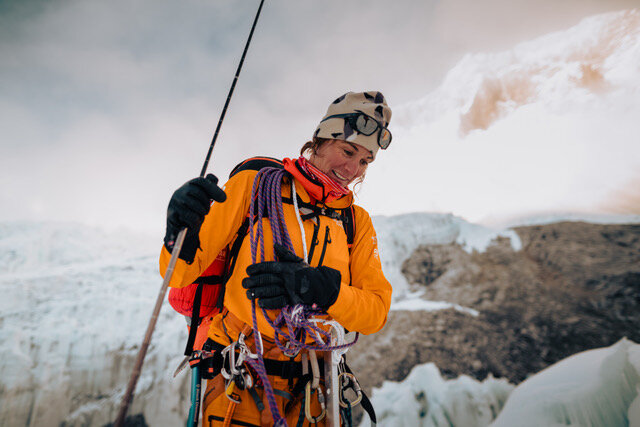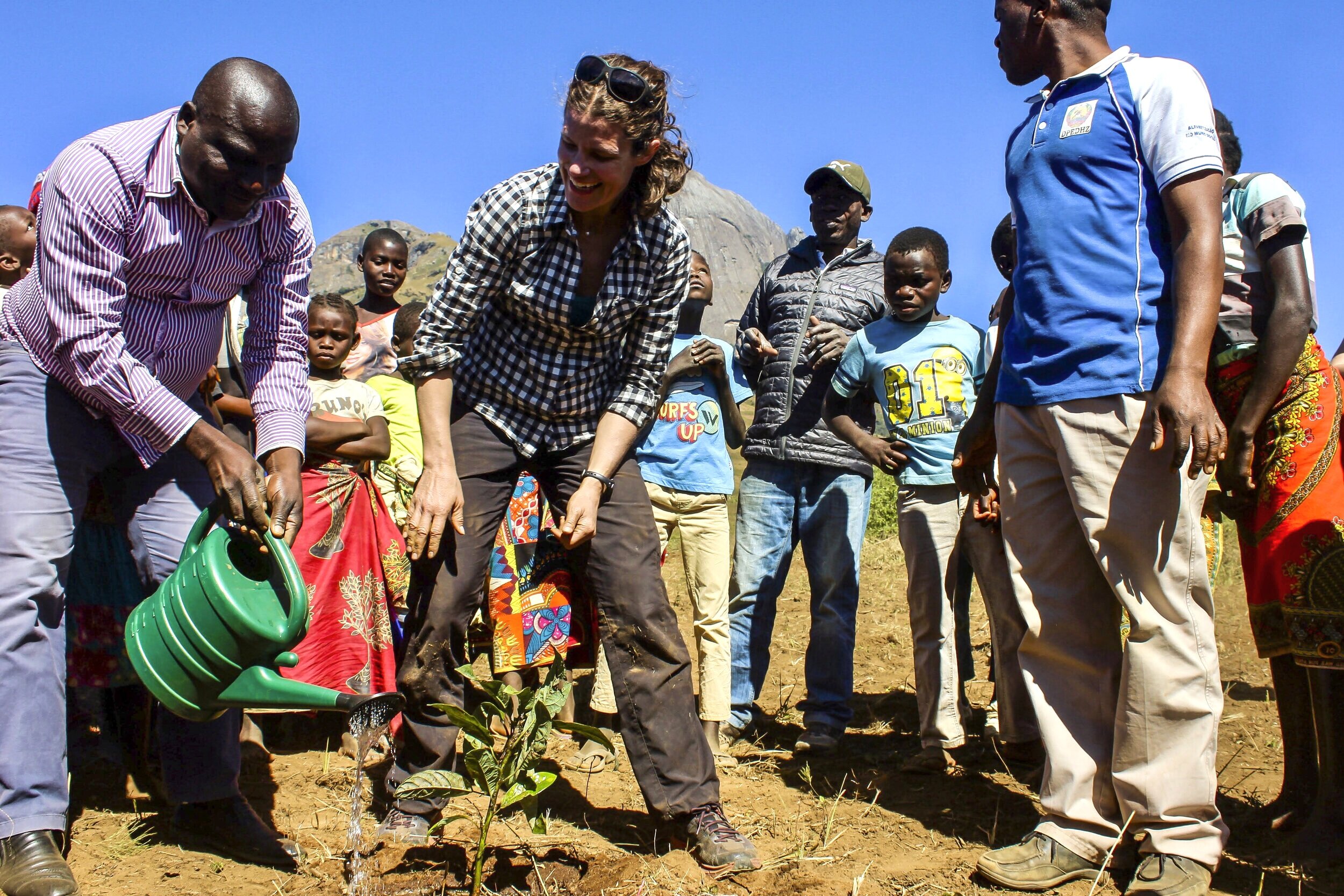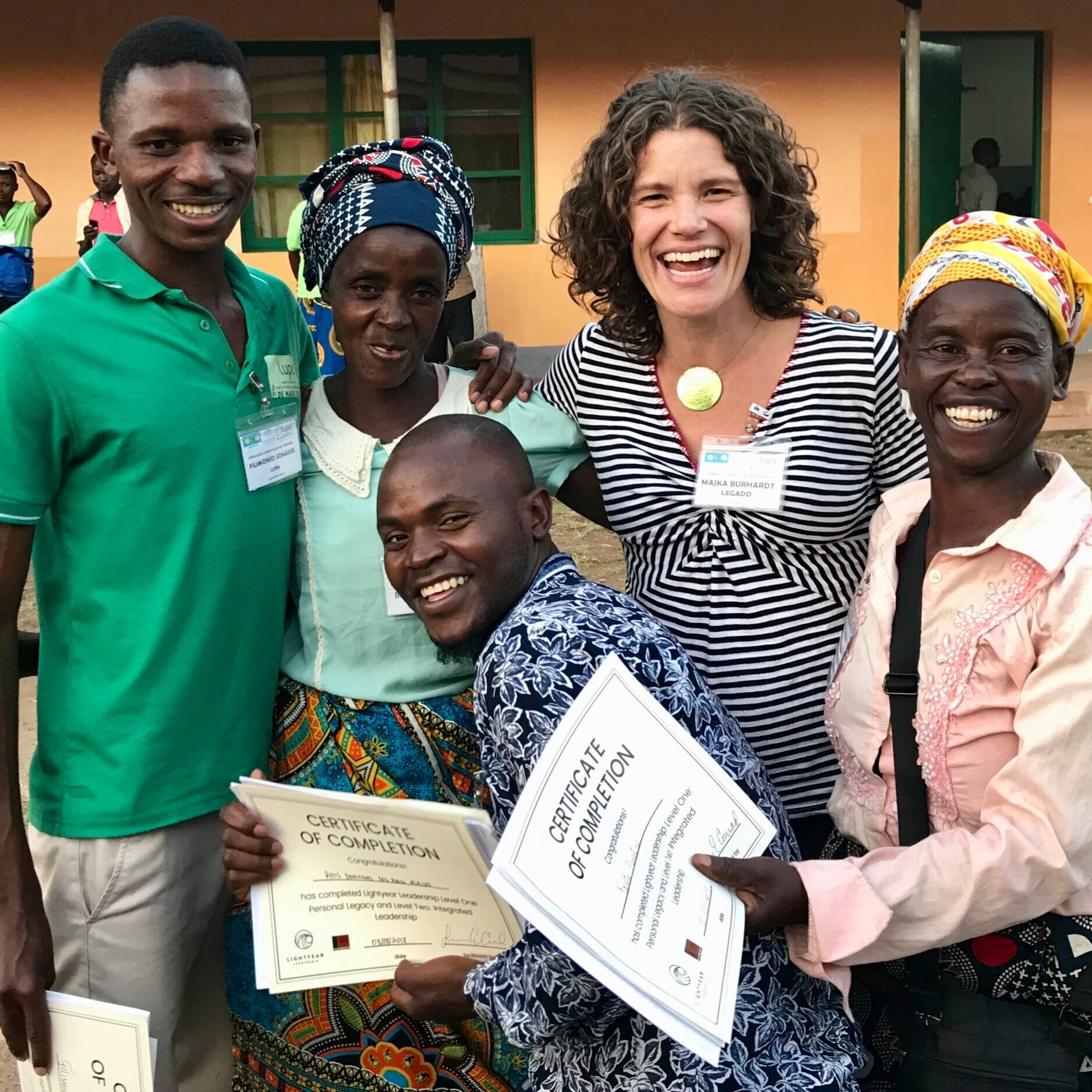MAJKA BURHARDT: WHEN ADVENTURE TURNS TO IMPACT
/Majka Burhardt works her way up Widow’s Walk in Crawford Notch, New Hampshire. A deep passion for climbing ultimately led her to engage with a remote mountain community in Madagascar, and then to launch and lead the nonprofit, Legado. Photo: Bernd Zeugswetter
Interview by Mary Anne Potts
New Hampshire-based Majka Burhardt is a superhero. She can climb almost anything, including ice, where she just became the first woman to receive the American Mountain Guides Association Ice Instructor certification (in addition to her rock guiding certification). She can use science and adventure to protect some of the most biodiverse places in the world, mountains referred to as “sky islands,” working in partnership with the local people to build a better future. And she can raise toddler twins—in a pandemic.
Majka’s journey toward creating a nonprofit began when she saw a photo of a peak in Mozambique. “I knew I had to learn more—I’d had no idea there was even granite there,” she recalls. That picture eventually led her to find Mount Namuli, now her flagship sky island location. “It was on my 2011 reconnaissance visit there that I saw that I did not want to go forward by only merging science and climbing on Namuli—I had to integrate that with working with local communities to conserve the future of their biodiversity,” the Patagonia-sponsored professional climber says.
In May 2014, she returned to lead an expedition of cliffside science and community building with an international team of biologists, climbers, conservation workers, and filmmakers who collaborated on Namuli, Mozambique’s second highest peak.
From that expedition, the idea for her non-profit, Legado, was born. Today Legado works to protect some of the most biodiverse mountains in the world, by working in partnership with local communities. Climbing—and what climbing has taught Majka—is threaded throughout their efforts. The goal of Legado is to scale to other sky island peak communities around the globe.
—Mary Anne Potts
Mary Anne Potts: How did your Namuli project use climbing to aid science?
Pioneering a research-focused route to the summit of Mt. Namuli in Mozambique, Majka and her expedition team of scientists and climbers celebrate topping out on the 1,200-foot granite peak. Photo: James Q. Martin
Majka Burhardt: The goal was to use climbing to facilitate the access for the scientists to be able to sample places they’d never been able to sample before. We wanted to draw attention to why this mountain is important, why we need to be protecting it from a biodiversity standpoint. We also wanted to make a splash with a film about putting all of these pieces together so that we could help the local community. Mount Namuli is in one of the most rural areas of one of the poorest countries in the world. We also furthered the understanding that its rainforest is also home to some of the most critical biodiversity on earth.
“When we started working on Mount Namuli, the government thought 3,000 people lived on the mountain. It turned out 12,000 people live there.”
MP: It sounds like an amazing place.
MB: When we started working on Mount Namuli, the government thought 3,000 people lived on the mountain. It turned out 12,000 people live there. So that four-fold error really demonstrates the lack of information that the Mozambique government had about the mountain people surrounding the Namuli.
But beyond an underestimation of population, this number then trickles down to the infrastructure support they have from the government and other NGOs. Legado was the first group to go in to create a concentrated effort working with people—the communities on Mount Namuli—not only to protect their mountain rain forest, but also to protect their way of life.
MP: What’s happening there now?
MB: We’ve been working there full time for six years across multiple platforms, from agriculture support to legacy building, honey production to local governance and land rights. For example, early on we started working with the local communities to change their agricultural practices to be more sustainable. On a practical level, a first critical step means hoeing the rows so that they are horizontal as opposed to vertical, so that nutrients remain in their soil, instead of getting washed out so easily.
The Macunha community members plant avocado trees at the base of Mt. Namuli in 2019 to expand the primary school orchard, providing a shaded space and fruit for the children. Photo: Legado Collection
To someone thinking from a geometric perspective about runoff, you could say, “Of course that’s how you do it.” But if you’ve ever tried to use a hoe horizontally in rocky terrain, you discover why vertical makes way more sense from a local standpoint.
Switching something as small as that, or our new initiative with honey production that starts with bee hives and brings the honey through the value chain to the consumer is huge. A big part of our work is to help bring in alternate incomes for the communities that live there, as well as working with them to honor the way of life that they’ve had for all these generations.
In a lot of ways, what Legado does is pause for a moment with these mountain communities and say, “Okay, what do you want this to be three generations from now? And how can we help you create that?”
Living in one of the poorest, most marginalized areas, in one of the poorest countries in the world, no one talks to you about your future. You are living on a day-to-day basis. So we prioritize taking time to work in a future-based scenario, and ask, “What does the future need to look like here, to have a successful future?”
Through this conversation, we get to understand a lot of inherent conservation values and sync up with where people want to take their lives.
MP: Was a national park established around that peak?
MB: No. Right now, we’re working to create a community protected area on Namuli—one of the first in Mozambique. At the same time, we’re also expanding. We’re launching [work at] another mountain, Mount Ribaue, in Mozambique, in November—COVID permitting.
“Back when I started working on Legado, everyone said, ‘There is no way. It’s going to be impossible. It’s so hard to work there. Why would you do this? It’s just not on the map.’”
Back when I started working on Legado, everyone said, “There is no way. It’s going to be impossible. It’s so hard to work there. Why would you do this? It’s just not on the map.”
But East Africa is fundamentally made up of these sky mountains. We like to call them the water towers for East Africa, taken together. I realized we needed a strategy that was small and hyper-local, but that could then scale, to protect much of East Africa’s rain forest.
With Namuli, we tried to create something that could actually be scalable. It’s a really exciting time for us, because we are now starting to scale it. It took us six years on Namuli, to refine [the program], and to ask, “How do we want to approach this? What does it mean to go somewhere else?” Now we’re actually putting that in place. We’re also looking at expanding into Indonesia and Central Asia--to different mountains there--where we’d work with other partners and communities.
Presenting on leadership and risk at a conference in Costa Rica, Majka Burhardt’s work involves public outreach for her nonprofit, Legado, which is focused on both environmental and cultural protection in “sky island” communities. Photo: SinterCafe
MP: Tell me about the next expedition.
MB: We are targeting November for the next expedition. We’re going to go to Mt. Ribaue, another Sky Island in Mozambique. It’s going to be similar to Namuli’s launch in that we’re combining climbing and science and community work, but the science is going to be pretty different. We’re going to be working with ornithologists to look at birds and with a lichenologist to look at lichens. One of the cool things about lichen is that a lot of the botanists have largely conducted traditional botany that was done in flat areas, or on different plateaus.
People had previously looked at these giant rock faces, and thought, “Nah, there’s nothing going on there.” But the reality is that when you start studying the lichens, the lichens appear differently at different elevations, depending on how competitive they’re being with other plants, and if they’re winning out or not. Lichen are seen as a bit of a canary in the coal mine for climate change.
And next to the lichen, we’re also going to be doing a bunch of bat surveys.
MP: Why bats?
MB: I’m terrified of bats, but yes, we’re going to be working with bats and birds and lichens. We’re also going to be doing another media piece about it, because for us, the daily work is what’s most important. But the media helps exert what we are doing in these mountains and build awareness for their protection on a local and global scale. .
Over the course of our work on Namuli, it—along with other Sky Islands—are now considered a main priority by the Mozambique government and their conservation strategy. That’s in large part because of all the press and publicity that our film, Namuli, helped generate. At Legado, we’re not only trying to inspire hyper-local action by working with mountain communities, but also national attention through media.
Then, on an international scale, really Legado’s goal is to have these mountains become part of a conservation mindset. They need a solution.
“Be very careful with your language and stay open to learning as you go along.”
Heading into a vertical unknown, Majka Burhardt and Kate Rutherford established the first ascent of the route, “Science Project,” on the southwest face of Mt. Namuli in Mozambique, 2014. Photo: Rob Frost
MP: You’ve really been able to accomplish a lot, as an outsider. Do you have any advice about how to have a genuine impact as an outsider?
MB: I think a big part about it is acknowledging what’s stacked up against you and acknowledging that history. Be very careful with your language and stay open to learning as you go along. The way I thought that I should be interacting six years ago is different than the way I interact now.
Being able to talk to people and emphasize that, “This is your land. This is your home. I’m here to talk to you about this.” It’s clearing up misconceptions. It’s trying to have a lot of integrity and a lot of transparency with the local groups. The solution is how do you do it in a way that feels genuine and honors people in the best way?
One thing that we’ve had a lot of success with is the leadership program we run. A lot of times, when people think leadership, especially in the context of conservation or development work, they think of working with the community leaders, or the people who are engaged in community government.
“When we talk about leadership, we’re talking about the people who are least likely to be consulted about their future. We do leadership programming for communities, not only their current leaders. We do it for anybody who wants to have a conversation about the future…”
But when we talk about leadership, we’re talking about the people who are least likely to be consulted about their future. We do leadership programming for communities, not only their current leaders, but we do it for anybody who wants to come and have a conversation about the future, which ties back into what we were talking about earlier.
We do this whole program about your personal vision for your life, and then what your goals are to get there—and it’s worked. What it does is it makes everybody human. I’m sitting there having a conversation about what my goals are for my future, next to a community member from Namuli, talking about their dreams for their future. I might say that my dream for my future is that my kids are going to go to college. For them, their dream right now might be that their kid is going to go to sixth grade. But they’re the same dream.
Being human, and acknowledging a shared humanity, lets us all relate. I will never be an insider--and it’s important to acknowledge that whenever you’re working in new communities around the world--but I’m a very human outsider.
MP: Do you have tips for how to build a genuine relationship?
Majka celebrating completion of the Legacy Leadership Program with the Legado field team members Filimonio Felizardo Jonasse and Galio Felizardo Zecas and their families in Gurue, Mozambique/2018. Photo: Curtiss Conrad.
MB: Listen more than you talk. One thing that we really try to do is to look at our answers from a lot of different perspectives. We work with our field team in Mozambique, we ask again and again “Okay, what do you guys think? Do you think we should change this? Where did I get this wrong? What happened? How could I do it better?”
We really created this culture within the team of being able to come back and reboot things. The opposite would be to be headstrong, without feedback, going forward. Instead, it’s really open for ongoing integration.
I think for me, it’s really interesting being a woman leading this international work. It rarely crosses my mind how rare it is to be in such a strong leadership role in these rural communities in Mozambique, where I’m working. But at the same time, I think the human factor in my work just skyrockets, because I’m not this big blustery guy coming in there.
For example, my life as a mom is part of my work and connection with the people who live on Namuli. They all know that I was pregnant and then nursing twins, and that’s why I wasn’t there for two-and-a-half years, but our field team was there every day. We talk about my twins all the time, and I often end up crying when I share my commitment to my kids and to this work with the communities. I’m a very emotive person, and it changes the structure of how I work. That’s not saying a man can’t do that, but rather that for me, this is something I do without trying because of who I am as a person who happens to be a woman.
MP: I feel like since I’ve become a mom, I relate to people in a really different way. Are you going to bring the twins when you go out?
Enjoying some family sled time in nearby Vermont, Majka with her husband, Peter Doucette, and their twins, Kaz and Irenna (bottom, right). Photo: Katie Marvin
MB: They’re not going to go on this trip, but they will go soon. Part of it is, on a mom note, when people ask me that sometimes I want to say, “Sure. If you can give me $10,000, I will happily take my twins with me!” So, I’m going to buy two more plane tickets. And I’m going to work, so then they need childcare.
It’s fascinating to me, because before I got pregnant, I thought, “I’ll just have one kid. It will be so easy. I’ll just tuck her under the wing, she’ll go everywhere, and I’ll be this super mom.” I had two, so all expectations were blown out of the water.
I wondered, “What the heck was I thinking? Of course, you need to take a nap. Of course, schedules are important.” It’s such a great reality check, and also humbling, to your point of you relating better to people. You’re like, “Oh, yeah. I really didn’t get it.”
The twins will come at some point, for sure, when they can be a little bit more self-sufficient, and we don’t have to spend as much on a nanny.
MP: How did you make it make sense financially to do this for a living?
MB: I spent much of my 20s in an amalgamated financial landscape combining guiding and writing. In my 30s, I added my social entrepreneurship work. It started with two books and a film, and then grew into Legado. When we started Legado, we had $11,000 of funding from companies in the outdoor industry. That was in 2011. Today [the funding] supports my role as the full time Executive Director for Legado, and I also derive income from my work as a professional climber.
INTERESTED IN BOOKING MAJKA BURHARDT TO PRESENT AT YOUR EVENT? PLEASE CONTACT US.
Connect with Majka on Instagram and on her website. You can learn more about the work of Legado at https://www.legadoinitiative.org.

















